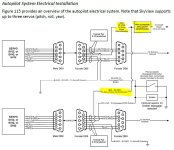claycookiemonster
Well Known Member
Installing Dynon Pitch and Roll A/P's in an RV8. I will also have Ray Allen Trim systems operated via the Dynon A/P's.
I will have an A/P disconnect switch on the stick, but I also wanted a switch to shut down the entire A/P system. As I wire this up, I was assuming I'd place the red guarded A/P OFF switch on the power lead to the A/P servos, but each servo has their own lead. Wiring them together complicates the VPX and prevents shutting down each axis independently. On the other hand, I could put the red guarded switch on the single power lead to the A/P Panel, but that would leave the servos powered even after shutting down the control panel. It would also kill the trim systems, as they are operated by the Dynon A/P.
How are you guys wiring things so a single switch can kill the entire A/P system?
I will have an A/P disconnect switch on the stick, but I also wanted a switch to shut down the entire A/P system. As I wire this up, I was assuming I'd place the red guarded A/P OFF switch on the power lead to the A/P servos, but each servo has their own lead. Wiring them together complicates the VPX and prevents shutting down each axis independently. On the other hand, I could put the red guarded switch on the single power lead to the A/P Panel, but that would leave the servos powered even after shutting down the control panel. It would also kill the trim systems, as they are operated by the Dynon A/P.
How are you guys wiring things so a single switch can kill the entire A/P system?





